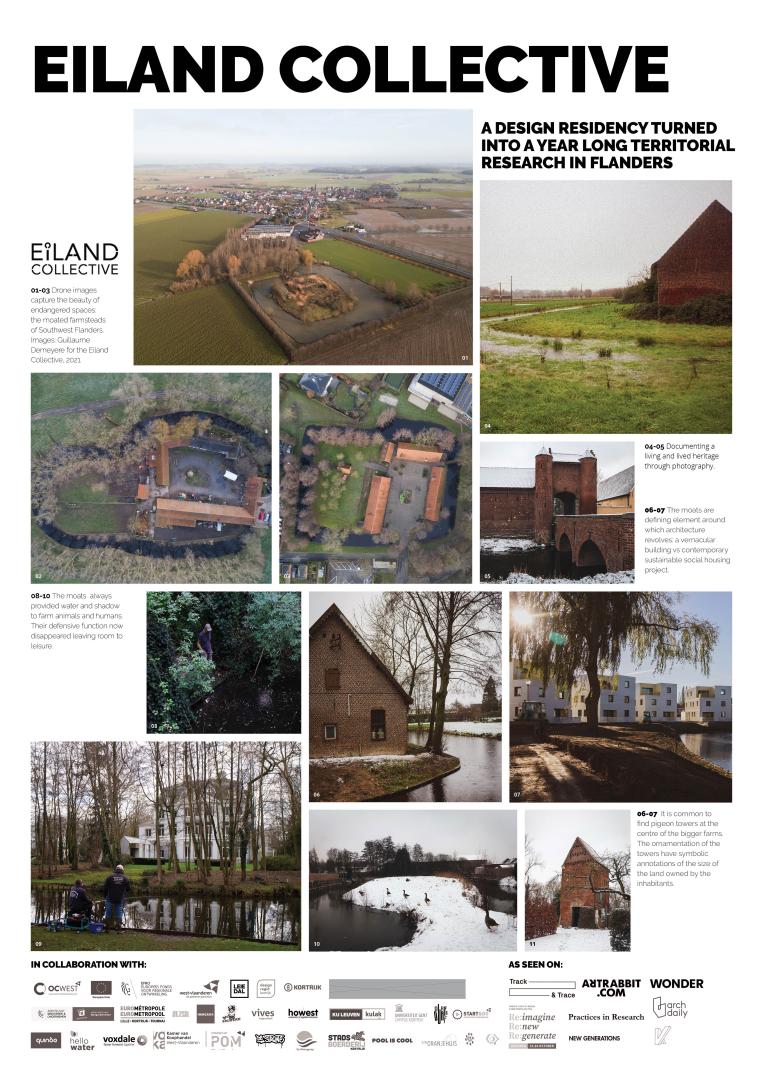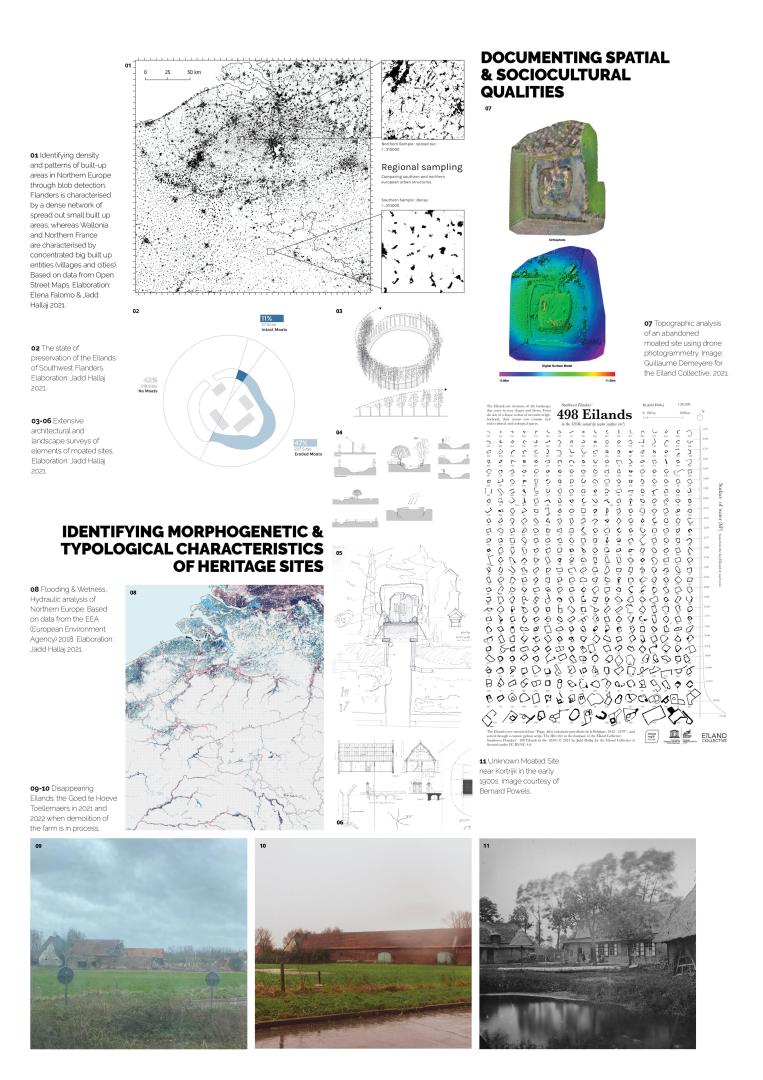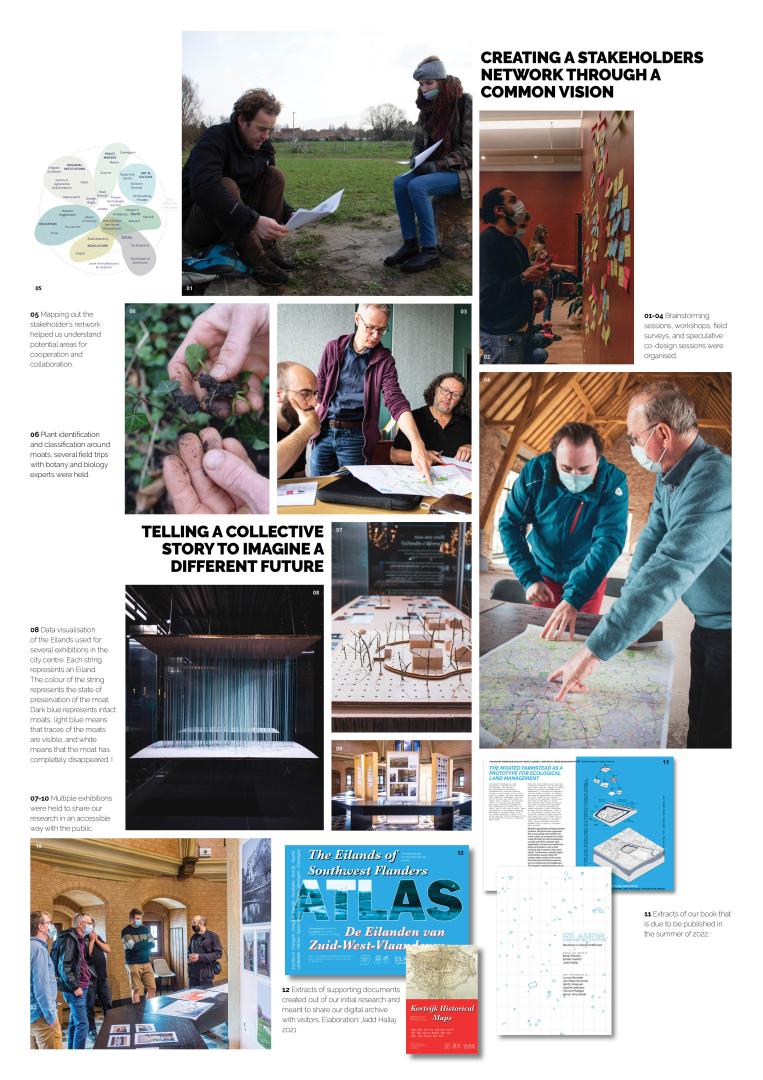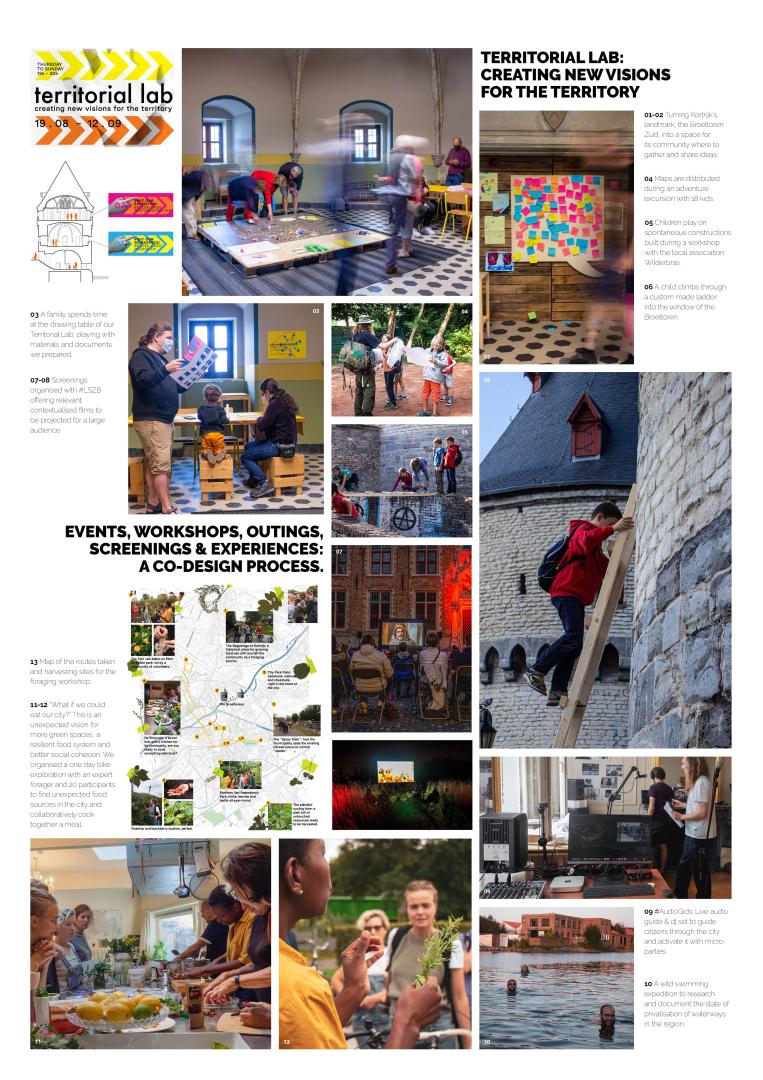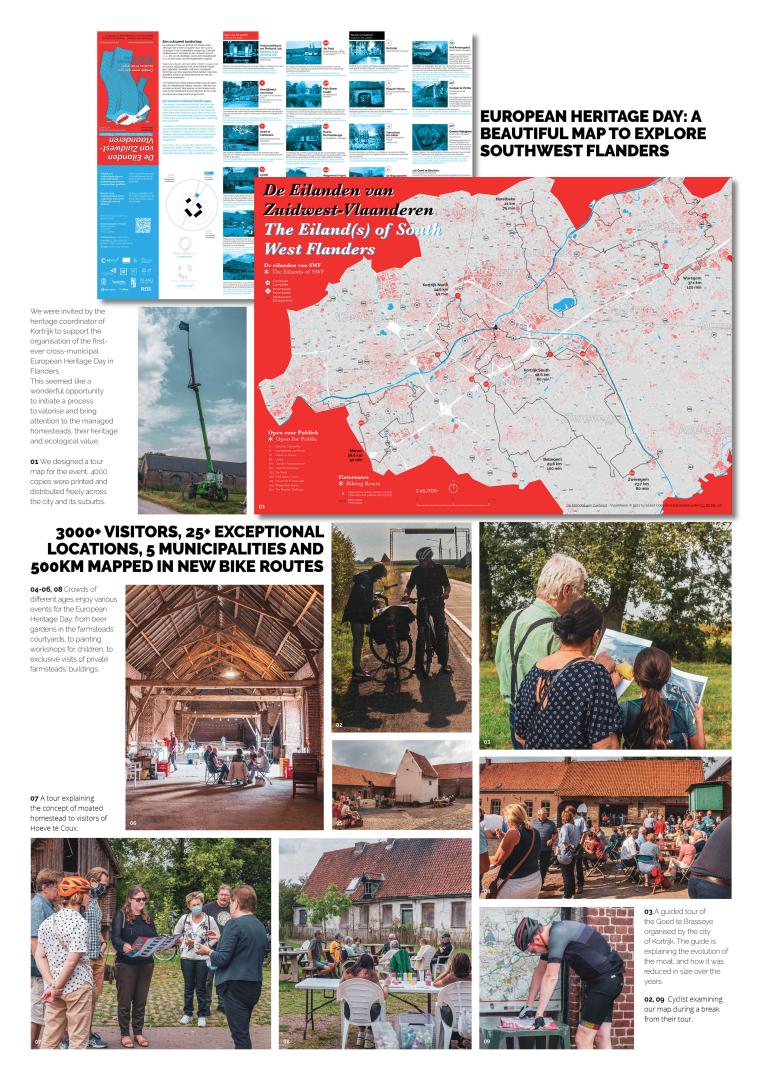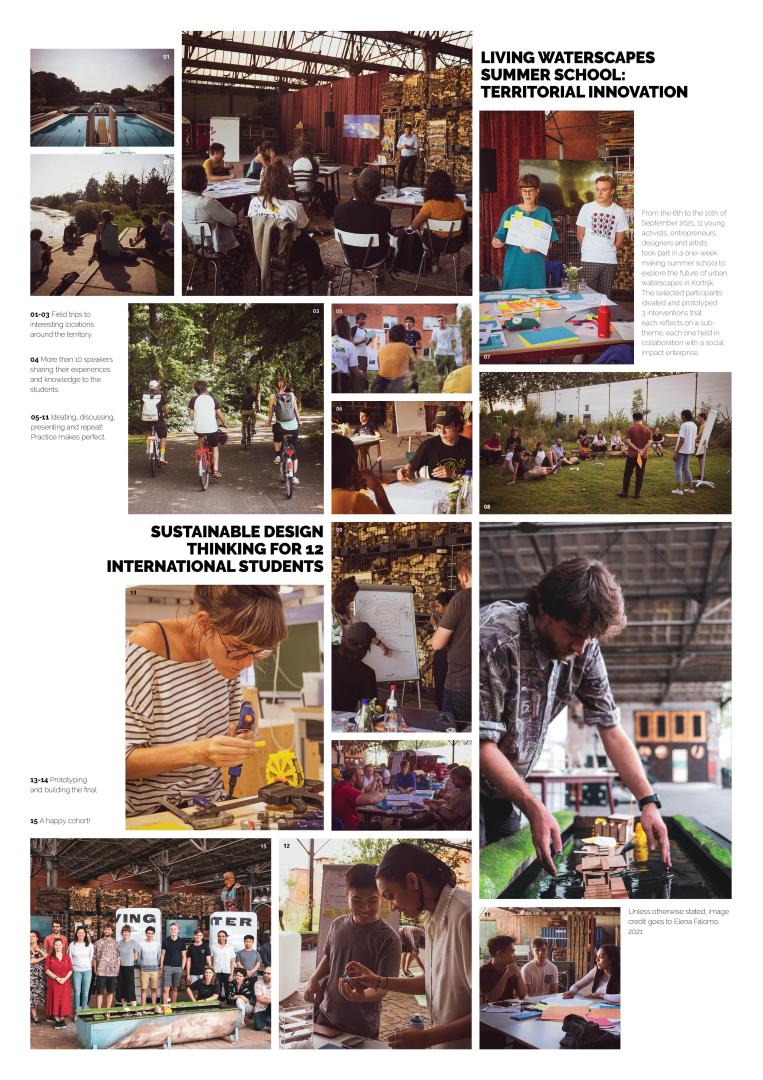Eiland Collective
Basic information
Project Title
Full project title
Category
Project Description
For three young designers, an artistic residency led to a year of advocating for the preservation of the Cultural Landscape of moated homesteads they helped unveil in Southwest Flanders.
They established the Eiland Collective and are now designing different initiatives to help grow an ecosystem of communities involved in shifting the development goals of their local environment. They want to explore sustainable design practices that rely on a newly-found sense of belonging.
Geographical Scope
Project Region
Urban or rural issues
Physical or other transformations
EU Programme or fund
Which funds
Description of the project
Summary
The Eiland collective is composed of two architects and an experience designer who were brought together during Designeregio’s Designers in Residency program of 2020. The initial theme of the brief “The Future of Urban Leisure'' brought our attention to the moated homesteads of Southwest Flanders. For more than a year (2020 - 2021), we researched this urban typology and developed several projects around the heritage they refer to as islands, or “Eilands”.
The moated homesteads of Southwest Flanders are vernacular settlements that are surrounded by water, hidden within the urban sprawl of the city. In late mediaeval times more than 500 of them constituted a network stretching from the urban centres to the countryside across the whole region, following the course of water.
Nowadays some sites have evolved into social catalysts with different vocations: educational, recreational, cultural, environmental... Some of these moated homesteads still have intact moats, others are incomplete, and many have altogether disappeared.
This is an imminent threat to the local environment, heritage and social capacity of the region. It was obvious that the future of this vulnerable landscape relied on a number of sustainability parameters at many scales of involvement. We, thus, set out to launch a process to document the landscape, raise awareness of its existence and vulnerability, and activate communities through concrete interventions.
This is how we moved from desk research to organising a Territorial Lab, a Summer School, the European Heritage Day and many similar initiatives.
We hope the work that will be described below will culminate one day in a UNESCO Cultural Landscape recognition. To reach this ultimate goal, we have spent a year prototyping different process-oriented activities described below that we aspire to concretize in a heritage management plan in the near future with the help of the Prize.
Key objectives for sustainability
During our research it was made evident to us that few people knew of the existence of moated sites in the region, and even less knew it as a recurring phenomenon throughout the landscape. We set out to build on this existing hidden landscape to branch out into different fields of sustainable development.
By building a new narrative through which communities could view their own territory, we could address growing concerns in water management, housing and displacement, the lack of social cohesion etc…
“I never saw the city this way”. This is recurring feedback we get from people who hear about the Eilands for the first time. The mental image of the eilands has started to bind otherwise isolated people in a common land/city-scape and to bring attention to pressing contemporary issues.
Our process could be summed up through 5 key objectives:
- Building a new image for the city and its countryside.
- Using this image to grow an ecosystem of stakeholders, decision makers and inhabitants out of existing networks.
- Engaging the ecosystem through designed community-oriented activities and platforms.
- Ensuring the longevity of our impact through different reports, publications, teaching opportunities and public talks.
The main lesson of the initial activities we held thus far, is that by capitalising on people’s sense of belonging it is possible to encourage a new relationship with one’s territory, and thus generate impactful sustainable processes.
Key objectives for aesthetics and quality
Historically, moated homesteads constituted a network of fortified mediaeval settlements that followed precise land management techniques combining the work of Man and Nature. We aim to rekindle this symbiosis by revisiting this heritage.
Eilands are a metaphor for the moated homesteads. This metaphor fashions a new image for the city. In a way, we are engaging in a trend that is widespread in Flanders, and surely across the globe, which is city marketing. We are in fact aiming to propose a counter-branding of the city, one of ecology, sustainability and heritage.
To document all of the Eilands, we created a multimedia digital archive that was made open source to crowd-fund the research. We used drone imagery to capture new images of the sites, and complemented them with qualitative surveying, archive research and consultations with local experts.
One of our aesthetic goals was to choose media able to capture and communicate to the audience the complexity of the relationship between the landscape and the built environment, whilst being immediately informative.
Therefore, after compiling this initial spatialised database, we decomposed the collected elements of the landscape into its different elements, and transformed them into communicable ideas. This neo-vernacular design language was the building blocks of how we constructed this new branding for the city, and the physical results of the design process that emerged out of it.
We are outputting different communication material, including many innovative maps for the region that would summarise our findings and would be the basis of all the activities to come. We focus on providing participants with immersive experiences by offering more than facts and numbers. We want to share a vision of the future of the territory that they could be a part of.
Key objectives for inclusion
People are not Islands. Or are they?
The Eilands metaphor, which defines a new image for the city, is also vital in engaging people in the valorisation process.
A common expression in Flanders is that “people are born with a brick in the stomach”. This expression refers to the care that people have in tending to their house. But it also addresses an underlying issue in Flanders, which is that people tend to care only for their house. Community engagement, bottom-up processes and any such collaboration is proving to be a challenging task. It would seem that communities are living in their own islands, and this is why community engagement is at the core of what we do.
Heritage is a key factor in leveraging this engagement, as it crosses barriers between people and places, and has the power to bind otherwise seemingly unrelated individuals. Through the material and immaterial heritage that the Eilands offer, we can foster a sense of belonging in communities and help collaboration thrive.
In order to achieve this, thanks to the different funds we have already received from our project partners, all of our activities and their corresponding support material, have all been free for our participants.
We also ensured to reach out to a broad spectrum of stakeholders, from private companies, to members of civil society, academic researchers, social farmers, political parties throughout the spectrum, corporations, ministries, municipalities and many others.
We are prototyping different workshop formats, and online platforms that would allow such deliberation to take place. Brainstorming sessions, workshops, field surveys, and speculative co-design sessions were organised, with the participation of a wide public of all ages and across geographies. For example, as part of our territorial lab, we held a wild foraging workshop and cooking workshop. We organised many urban expeditions and wild outings.
Physical or other transformations
Innovative character
It is important to identify and grow the existing social context through an ecosystem that needs to perform in the quantity of members, but also in the quality of their relationships. We aspire to find creative and reproducible ways to influence change. So far the Eiland collective has managed a large number of initiatives, including but not limited to:
- Territorial Lab: a month-long experiment in a vacant space in the city centre of Kortrijk. Through collaborations with local stakeholders and citizens, it explores different practices that reflect complex and multilayered visions on the region.
- Exhibitions: More than 5 temporary exhibitions across the region that showcase the history and potential of the Cultural Landscape, using different visualisation and mapping techniques.
- Map Rooms: A series of community-based counter-cartographies exercises to develop new narratives alternative mainstream development trends.
- European Heritage Day: We coordinated and designed a first of a kind inter-municipal heritage day on the theme of the Eilands of Southwest Flanders. More than 3000 people participated in visiting different sites and participated in various activities with supporting materials that we designed such as maps, online platforms and bike routes.
- Living Summer School: for 5 days, 11 local and international students ideated and prototyped different solutions for sustainable water management in the region, they were coached by more than 10 local experts and were introduced to design thinking and rapid prototyping.
- Publication: more than 10 local and regional experts and practitioners have joined us in writing and editing a 150 page book that is due this summer for publication.
- Local education opportunities: The Eiland Collective has also been invited to participate in coaching and mentoring students in local universities.

